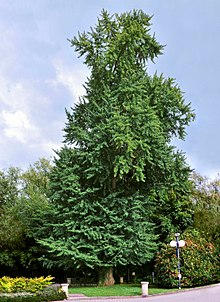| Ginkgo biloba | |
|---|---|

| |
| Scientific classification | |
| Kingdom: | Plantae |
| Clade: | Tracheophytes |
| Clade: | Gymnospermae |
| Division: | Ginkgophyta |
| Class: | Ginkgoopsida |
| Order: | Ginkgoales |
| Family: | Ginkgoaceae |
| Genus: | Ginkgo |
| Species: | G. biloba
|
| Binomial name | |
| Ginkgo biloba | |
| Synonyms[4] | |
| |
Ginkgo biloba, commonly known as ginkgo or gingko (/ˈɡɪŋkoʊ, ˈɡɪŋkɡoʊ/ GINK-oh, -goh),[5][6] also known as the maidenhair tree,[7] is a species of gymnosperm tree native to East Asia. It is the last living species in the order Ginkgoales, which first appeared over 290 million years ago, and fossils very similar to the living species, belonging to the genus Ginkgo, extend back to the Middle Jurassic epoch approximately 170 million years ago.[2] The tree was cultivated early in human history and remains commonly planted, and is widely regarded as a living fossil.
The plant may be toxic or allergenic in certain cases. Leaf extract is commonly used as a dietary supplement, but there is insufficient clinical evidence that it supports human health or is effective against any disease.[8][9]
- ^ Mustoe, G.E. (2002). "Eocene Ginkgo leaf fossils from the Pacific Northwest". Canadian Journal of Botany. 80 (10): 1078–1087. doi:10.1139/b02-097.
- ^ a b Sun, W. (1998). "Ginkgo biloba". IUCN Red List of Threatened Species. 1998: e.T32353A9700472. doi:10.2305/IUCN.UK.1998.RLTS.T32353A9700472.en. Retrieved 19 November 2021.
- ^ "NatureServe Explorer 2.0". explorer.natureserve.org. Retrieved 31 March 2022.
- ^ "Ginkgo biloba", World Checklist of Selected Plant Families, Royal Botanic Gardens, Kew, retrieved 1 July 2024
- ^ "Ginkgo: Definition & Meaning". www.merriam-webster.com. Retrieved 2 July 2021.
- ^ "ginkgo". dictionary.cambridge.org. Retrieved 2 July 2021.
- ^ USDA, NRCS (n.d.). "Ginkgo biloba". The PLANTS Database (plants.usda.gov). Greensboro, North Carolina: National Plant Data Team. Retrieved 19 January 2016.
- ^ "Ginkgo". National Center for Complementary and Integrative Health, US National Institutes of Health. 1 August 2020. Retrieved 19 February 2021.
- ^ "Ginkgo biloba". Drugs.com. 19 December 2023. Retrieved 13 April 2024.

